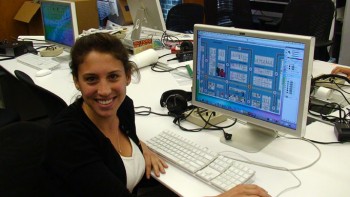Exploring Philadelphia's Past

Details
When her boss ordered her to take a leisurely walk through Philadelphia's historic Seventh Ward, a narrow corridor that stretches from 7th Street to the Schuylkill River and from Spruce to South Streets, Julia Dunbar '10 couldn't believe her luck: restaurant-hopping and shopping her first day on the job. But her boss knew that taking in the Seventh Ward would be more than just a fun excursion for this history buff.
Dunbar, one of nine rising seniors who received stipends from the Hurford Humanities Center to work with local organizations and develop their career interests this summer, is interning with the Mapping Du Bois project at the University of Pennsylvania School of Design.“The Seventh Ward has historically been [home to] a concentration of black populations in Philadelphia,” she explains. “Now it's pretty affluent, but a lot of people don't know how it used to be.”
The Mapping Du Bois project aims to illuminate the Seventh Ward's diverse past. Using Du Bois's late 19th century sociological study of the Seventh Ward, The Philadelphia Negro, as a springboard, the project is educating Philadelphia-area high school students through a variety of provocative media: a documentary, board game, interactive online map of the Seventh Ward, and classroom curriculum.“The overall intention,” says Dunbar,“is not only to learn about Philadelphia history but also to use the history of this neighborhood to start a conversation about race relations.”
An avid history major, Dunbar has had a hand in all aspects of the project. Working closely with Katy Schaeffer '10 to finish the board game, Dunbar has picked up from where two Haverford alumni, Mari Christmas '08 and Duncan Cooper ‘09, left off. The board game, a map of the Seventh Ward with a path winding through it, teaches students about Philadelphia history through four categories of questions: acting, drawing, facts, and quotations from Du Bois's book. Dunbar and Schaeffer drew many of the questions from Du Bois's work, research in the Philadelphia archives, and interviews with high school students.
“As you move through the board, you get an idea of what life might be like for someone living there,” says Dunbar. Even the game pieces represent former residents of the Seventh Ward.“There are character profiles in the game as well, which is another way to incorporate actual people,” she says.
So far, test runs of the game at the Julia R. Masterman Laboratory and Demonstration School and West Philadelphia High School have brought promising results. Meanwhile, two high school students have been putting together the 30-minute documentary for the past two summers. Dunbar emphasizes that the film“brings the past into the present by showing what the ward is like today and how it's changed in the past 100 years.”
The online map, www.mappingdubois.org, which was constructed from 1900 U.S. Census data and geographic information systems (GIS) technology, gives students and Philadelphians alike instant visual access to the ward's history. With the click of a button, viewers can select any house on the map and find out a variety of information, including who lived there, what they did for a living, how long they resided there, and whether they could read or write.
With the board game at the printer and the documentary in its final stages of production, Dunbar's team hopes to disseminate the package of materials as part of classroom curriculum. Having worked at a historical society in a very different section of Philadelphia, Society Hill, last summer, Dunbar says,“I just really like looking at different areas and understanding why the city is the way it is today.” She hopes that their target audience, local high school students, will feel the same way.
—Nicole Gervasio BMC '10



